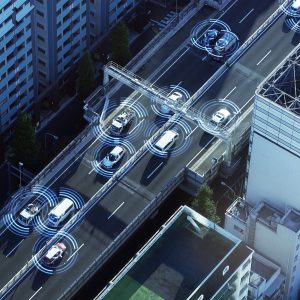 Autonomous vehicles create tons of data—Intel, in a 2017 newsroom editorial, projected that a connected vehicle’s hundreds of onboard sensors would generate up to 4 terabytes of data daily over about an hour and a half of driving, the approximate amount of time someone spends in their car each day. Some autonomous vehicles, like trucks, taxis, ride hails and delivery vans, will generate even more information due to longer hours on the road. And not only is each vehicle spawning data—the information must be shared vehicle-to-vehicle and vehicle-to-everything (like roadside and infrastructure) to make autonomous mobility a reality.
Autonomous vehicles create tons of data—Intel, in a 2017 newsroom editorial, projected that a connected vehicle’s hundreds of onboard sensors would generate up to 4 terabytes of data daily over about an hour and a half of driving, the approximate amount of time someone spends in their car each day. Some autonomous vehicles, like trucks, taxis, ride hails and delivery vans, will generate even more information due to longer hours on the road. And not only is each vehicle spawning data—the information must be shared vehicle-to-vehicle and vehicle-to-everything (like roadside and infrastructure) to make autonomous mobility a reality.
This is ultimate IIoT: everything along the vehicle’s path, sending sensor-based IIoT readings for interpretation and reaction. This data collection and sharing imperative demands intelligent “everything,” enabled by tools like edge/fog computing, 5G, digital twin, and a unified, digital cloud-based collaboration platform.

Edge/fog computing will “empower” objects in the vehicle’s environment with small-form processing at or near each asset, speeding data processing and shedding some load off the cloud. 5G shows promise as the “highway within the highway,” spiriting data at blazing speeds across the autonomous ecosystem. The digital collaboration platform in the cloud can then harvest and crunch performance data from goings-on in the street below. It can convey real-world lessons learned to Model-Based Systems Engineering (MBSE) and digital twins, so autonomous vehicle makers and their suppliers can simulate the reconfiguration of sensors, software and electronics to update vehicles on the road and new vehicles under development.
This is bringing momentous changes to vehicle makers. They’ve already glimpsed it through introducing cameras, sensors and compute power into traditional vehicles for driver-assist, streaming content-rich data snapshots of vehicle performance and driver habits back to the OEMs. But the data flood from autonomous vehicles is another order of magnitude in volume and speed. Vehicle makers have already mastered how to compress product lifecycles through more digitization of the product development process; in the autonomous vehicle space, these changes will have to be made at the fast-forward speed of tech.
It’s axiomatic that autonomous vehicles have blurred the lines between manufacturers and technology companies. Manufacturers will be judged in the autonomous marketplace not only by their engineering and mechanical excellence, but by the acuity and robustness of their electronics and algorithms, and their ability to quickly process “intelligent-everything” data as the vehicle navigates the surrounding world.
Vehicle manufacturers have a leg up on this through their work with the IIoT in their production facilities. They’ve gained expertise in “smartening up” inanimate assets and devices, connecting them to a (typically) cloud-based collaborative platform, and responding quickly to streams of status updates by transforming the data points into executable instructions and trends analysis.
They say that when a butterfly flaps its wings, that small change in one place may lead to a tornado in another. Every individual event in the environment that surrounds the autonomous vehicle will likewise trigger a cascading chain of variable occurrences.
Welcome to Ultimate IIoT.
